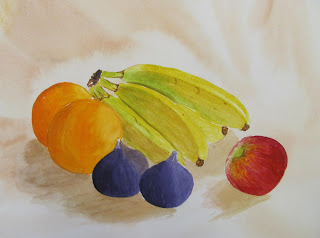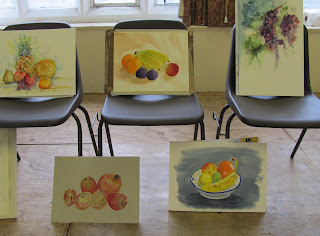Amongst the many fine artists I have discovered over the last year or two is Bev Jozwiak. I can't recall exactly how I found out about her, but discovery soon led to an admiration of her colourful and impressionistic work, together with interesting subject matter. As well as being a wonderful artist she is also a very nice person as I discovered when asking assistance in producing this feature.
Born in Vancouver, Washington, Bev is a Signature member of the American Watercolor Society and many others too numerous to list. She is an International award winning artist and her website - well worth a visit
www.bevjozwiak.com/ gives much detail of her career along with a large gallery of her paintings.
The following are examples of her `crow' paintings, highly original to say the least.
This statement from her website epitomizes her philosophy:
"Painting very directly, I place my watercolors on the paper with very little mixing on the palette. I use lots of varied colour in my blacks to keep them from going flat, in my whites to keep them glowing, and even in my skin tones to keep them interesting.
Emotion plays an important part in every successful painting, so I choose only subjects that call to me and that gives my work energy and excitement."
Bev is represented by several galleries and one of them had this to say at a recent exhibition of her paintings:.
"the Cole Gallery in Edmonton represents forty artists and hosts a rotating feature exhibition of each artist. The current artist featured is Bev Jozwiak. Jozwiak is a signature member of the Norwest Watercolor Society. Curator, Dennis Cole, claims that of the workshops offered to artists, Jozwiak's are the most popular.
Jozwiak's featured watercolor paintings depict figurative and avian subjects. her figurative work in this exhibition is split between young women and children. One of her avian subjects is a rooster; the rest are crows. Whether she is painting birds, a bride's maid or women waiting for the No.9 bus, Jozwiak's approach is both energetic and memorable.
Her colors are intense and her contrasts lively, but the source of her `Wow' factor, and she does have the `Wow' factor, is her expressive and deliberate brush strokes. Jozwiak's painting style is intensely personal. Her work appears to be driven by a kinetic relationship with her world.
The edge of a shape is a critical transition in artwork. Edges are said to come in three flavors: hard, soft and rough. Jozwiak's edges move beyond the standard. Her edges can be jagged, gestural, bleeding, spattered and at times the pigment simply fades out into a solitary pencil contour line defining the shape.
Jozwiak paints with bold brushstrokes. Paint is often thick and opaque. She characteristically mixes pigment on the paper rather than the palette, which results in surprising color juxtapositions.
Her compositions are engaging. Most of her children are active. In Budding Artist a child is painting. In Life's little Treasures children are curiously searching the ground for that perfect little object to take home and put in a jar on the shelf. The young women in Jozwiak's show are waiting. In Bus Stop Conversation and Waiting on No.9, they are waiting for the bus. In `All Dressed Up...' the subject appears to be waiting for a date to show up. All of Jozwiak's figures appear to be embedded in their own reality. The gaze of the figures is always behind the frame, rather than out of the frame toward the viewer. Directing the gaze of the figures is always behind the frame rather than the out of the frame toward the viewer. Directing the gaze of the subject behind the frame, the artist contains the energy in the image she has created. We are allowed to peer in, but the subjects do not notice us. The effect enlarges the virtual world of the subject.
Jozwiak is playful as well as expressive. When she paints crows, she represents a bird that is familiar with the human world. In Traffic Cop II a crow is shown perched on a traffic signal light. In Crow Bar II a crow has found its way into a traditional still life of grapes, wine glasses and bottles. The crow has a grape in its beak. These scenes may sound cute, and while Jozwiak works with humour, her images go beyond cute. Even in these tame situations, her crows have a mischievous wildness about them."
This accompanied an exhibition in June 2012 and a selection of her work is on permanent display. The Cole Gallery is at
http://www.colegallery.net
Below are some of Bevs latest work - not yet on her website - which she kindly sent me. I do see a change in emphasis with colour. One thing that attracted me to her work was her use of brilliant colour, especially red, and this has been toned down in these paintings. You can see many subtle colours and the use of complements.
The Diploma II
Man of the Hour
World Beat
Big Dreams
+sm..jpg)
Three Dancers
Bev has also supplied the following `mission' statement, if that is the right expression.
"The style I am currently working in seems to be the direct result of my own personal journey. I can paint thick, dark and dramatic. to light loose and washy, all in one piece. Who says you can't have it all.
From an oil like look to dripping puddles, I love the spontaneity and freshness of watercolor. It has the capabilities to be hard edged in one stroke and washed out in the next. Watercolor is the perfect medium for creating edge variety, soft, hard,blurred or focussed. Lost and found edges help to create movement throughout the painting. I try not to get bogged down with finishing every detail. When you do your edges become hard, thus stopping the eye from travelling through your piece."
I have always been under the assumption that paintings should look like paintings, and not photographs. With that in mind, try to create movement in your work by showing brushwork, adding water, creating runs, drips and splatter. Experiment with the uniqueness of watercolor. Be bold, fear tends to make you tighten up. Don't just be a recorder of facts; keep in mind that you do not need to reproduce everything that you see. being freed up from exact rendering helps you concentrate on what the medium can do, rather than worrying about the small details.
This medium can be so versatile so don't fight it. Don't work against it; let it be in all its glory"
So there you have it!
More examples of Bevs work.
Now down to the nitty gritty of materials. Her palette is a John Pike, this is a very large, flat, hard plastic palette with 24 wells. It has a lid that you can also use for mixing. An illustration appears in one of my earlier posts on palettes. Paper is 140lb Fabriano Hotpress and the following Winsor & Newton tube paints, but note exception. Yellow Ochre, Quinacridone Gold (opt), Burnt Sienna, Sap Green (Holbein), French Ultramarine Blue, Cobalt Blue (opt), Manganese Blue Hue, Alazarin Crimson, Rose Madder Genuine, Cadmium Red, Cadmium Orange (opt), Winsor Blue (Red Shade (opt), Winsor Blue (Green Shade) (opt), Cadmium Yellow,
Brushes are Cheap Joes Golden Fleece (a large American mail order supplier) , Bev says she has expensive brushes but `I always seem to paint with these inexpensive brushes from Cheap Joes, almost exclusively a number 10'.
This is a long piece but I felt there is so much interesting and useful information that I have printed it in full. Almost a mini Masterclass in itself. Thank you so much Bev and I look forward to seeing more of your work in future.









































sm.jpg)
.jpg)
.jpg)
.jpg)
+sm..jpg)





